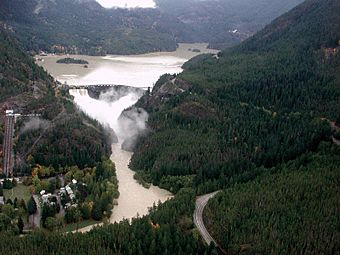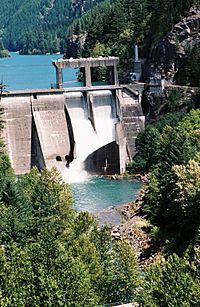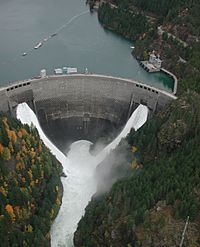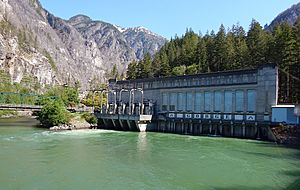Skagit River Hydroelectric Project facts for kids
|
Skagit River and Newhalem Creek Hydroelectric Projects
|
|
 |
|
| Lua error in Module:Location_map at line 420: attempt to index field 'wikibase' (a nil value). | |
| Location | Whatcom County, Washington |
|---|---|
| Nearest city | Newhalem, Washington |
| Area | 42 acres (17.0 ha) |
| Built | 1917 |
| Architect | Lars Jorgenson |
| Architectural style | Classical Revival, Bungalow/American craftsman, Industrial |
| MPS | Hydroelectric Power Plants in Washington State, 1890–1938 MPS |
| NRHP reference No. | 96000416 (original) 11000016 (increase) |
Quick facts for kids Significant dates |
|
| Added to NRHP | April 26, 1996 |
| Boundary increase | February 11, 2011 |
The Skagit River Hydroelectric Project is a group of dams and power stations. These stations use the power of water to create electricity. They are located on the Skagit River in northern Washington State. Seattle City Light owns and runs this project. Its main job is to provide electric power for the city of Seattle and nearby areas.
In 2012, about 89.8 percent of Seattle's electricity came from hydroelectric dams. The Skagit Hydroelectric Project alone provides about 20 percent of all the electricity used by Seattle City Light customers.
Contents
Building the Skagit Dams
In 1917, a man named James Delmage Ross was in charge of lighting for Seattle. He got permission to build dams on the Skagit River. The city council then approved $1.5 million to start building. They chose Carl F. Uhden to lead the project. Workers set up a camp at the mouth of Newhalem Creek. This camp later became the community of Newhalem.
Early Challenges and Delays
Uhden hired people to build a 25-mile railroad line. This line went to Gorge Creek and helped Seattle City Light control who could enter the area. After the railroad reached the site, workers dug a two-mile tunnel. This tunnel connected the dam to the powerhouse. Building the project was very hard. Work often stopped because of floods, mudslides, and avalanches.
Other problems also caused delays. Some workers left to look for gold. There were also worker disagreements, a big forest fire, and not enough electricity. James Ross thought the project would power Seattle by 1921. But all these problems pushed the start date to 1924.
A Presidential Start
The generators at the Gorge Dam officially started working on September 17, 1924. President Calvin Coolidge himself turned them on!
Recent Events
In August 2021, Seattle City Light announced something important. They said they would study if they should remove one or more of the Skagit dams. This study is for environmental reasons. In August 2023, a wildfire called the Sourdough Fire threatened the dams. This fire made City Light workers leave the area. It also caused the dams to produce less electricity for a while.
The Skagit River Dams
The Skagit River Project has three main dams. They are, from lowest to highest on the river: Gorge Dam, Diablo Dam, and Ross Dam. These dams are in Whatcom County. They are above the town of Newhalem, which is just west of North Cascades National Park. Ross Lake, which is formed by Ross Dam, even goes into British Columbia in Canada. This lake is 20 miles upriver from the dam. The Ross Lake National Recreation Area is all around the lake.
Gorge Dam
Building Gorge Dam started in 1921. The first electricity from it reached Seattle in 1924. This dam cost $13 million at the time. In 1961, a new, taller Gorge High Dam was finished. It is 300 feet (91 meters) tall. This new dam replaced the original Gorge Dam.
Diablo Dam
Construction on Diablo Dam began in 1927. It is five miles upstream from Gorge Dam. Diablo Dam was finished in 1930. At that time, it was the tallest dam in the world! It stood 389 feet (119 meters) high. Even though the dam was built, there were money problems because of the Great Depression. This delayed building the powerhouse. So, the dam did not make electricity for Seattle until 1936.
Ross Dam
Building the dam at Ruby Creek started in 1937. This dam was later renamed Ross Dam. It was named after James Delmage Ross, who was the superintendent of the Skagit River Project. He passed away in 1939. Ross Dam was built in three steps. The first step was done in 1940. The second and third steps were finished in 1953. That's when the dam reached its final height of 540 feet (160 meters).
All three of these dams are important historical sites. They are listed on the National Register of Historic Places. The total cost to build the entire Skagit River Hydroelectric Project was $250 million over 50 years.
How Much Power the Dams Make
The Skagit River dams produce a lot of electricity. Here's how much power each dam can make:
| Dam | Power (MW) | Location |
|---|---|---|
| Gorge | 199.2 | 48°41′52″N 121°12′30″W / 48.69778°N 121.20833°W |
| Diablo | 159.3 | 48°42′51″N 121°07′52″W / 48.71417°N 121.13111°W |
| Ross | 352.6 | 48°43′54″N 121°04′02″W / 48.73167°N 121.06722°W |
| Total | 711.1 |
—
|
Visiting the Skagit Project
From 1928 until World War II began, City Light offered tours of the Skagit Project. Visitors would ride City Light's steam train 23 miles from Rockport to Newhalem. They could stay in dorms and eat meals at The Gorge Inn. The next day, they would take another train to Diablo. There, they toured the powerhouse and rode a special lift to the top of the dam. After that, they rode a boat to Ruby Creek. Then, they returned to Rockport. By 1941, over 100,000 people had visited the Skagit Project! After the war, shorter tours started again.
Today, City Light still offers tours. These include boat tours, walking tours, and tours that combine walking with a van ride.




